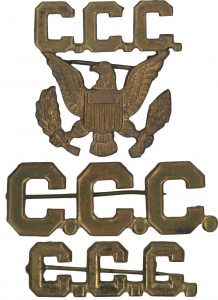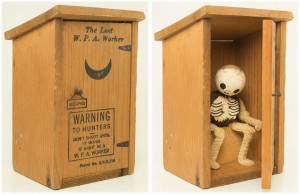Franklin Delano Roosevelt was elected on a promise of action to meet the challenges of the Great Depression head on. Following his inauguration in 1933, he proceeded to make good on that promise.
Today's New Listings features items promoting a series of domestic programs enacted by executive order of President Franklin D. Roosevelt; the Works Progress Administration (WPA), the Civilian Conservation Corps (CCC), and the National Recovery Administration (NRA). These programs, in addition to a host of others, came to be known as FDR's "New Deal" with the American people.
 Civilian Conservation Corps brass badges.
Civilian Conservation Corps brass badges.The Civilian Conservation Corps was a domestic work relief program that operated from 1933 to 1942. Unemployed, unmarried men were put to work in conservation and natural resource development efforts on federal, state and local lands. That the program provided much-needed work to the scores of unemployed young men during the dark days of the Depression while implementing these conservation efforts made it one of the most universally supported of New Deal programs. Over the nine year lifespan of the program, 3 million participated and were provided with food, clothing, shelter, and a small wage of $30 a month, $25 dollars of which was required to be sent back to their families.
 The iconic N.R.A. eagle logo and "We Do Our Part" slogan.
The iconic N.R.A. eagle logo and "We Do Our Part" slogan.The National Recovery Administration was the central New Deal agency, established by FDR in 1933. The goal of the NRA was to bring industry, labor and government together to create codes and "fair-practices" such as minimum wages, maximum work shift hours, and minimum prices at which goods were to be sold. Although popular with workers, the NRA law was declared unconstitutional in a unanimous decision by the US Supreme court in 1935, although many of its provisions were reestablished in the Wagner Act passed later that same year. The lasting legacy of the NRA would prove to be a surge in the power of the labor unions which would become the core of the New Deal Coalition, who's influence on the shape of US politics would be felt for decades to come.
 A lighthearted look at a "lost" WPA worker
A lighthearted look at a "lost" WPA workerThe Works Progress Administration was a large and ambitious public works agency that put millions of unemployed people to work on projects large and small, including parks, roads, bridges, and public buildings. The infrastructure built by the WPA still leaves an imprint on nearly every community in America, where it's not uncommon to find a "Built by the WPA" plaque or stamp on a sidewalk or train bridge.
We hope you enjoy today's New Listings.



